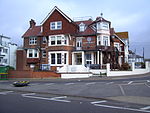St Bernard's High School, Westcliff-on-Sea
1910 establishments in EnglandAcademies in Southend-on-SeaBilateral schools in EnglandCatholic secondary schools in the Diocese of BrentwoodEducational institutions established in 1910 ... and 2 more
Secondary schools in Southend-on-SeaUse British English from February 2023
St Bernard's Convent High School is a girls Catholic bilateral secondary school located in Westcliff-on-Sea, Essex, with a mixed sixth form.
Excerpt from the Wikipedia article St Bernard's High School, Westcliff-on-Sea (License: CC BY-SA 3.0, Authors).St Bernard's High School, Westcliff-on-Sea
Hermitage Road, Southend-on-Sea Prittlewell
Geographical coordinates (GPS) Address Phone number Website External links Nearby Places Show on map
Geographical coordinates (GPS)
| Latitude | Longitude |
|---|---|
| N 51.5374 ° | E 0.6986 ° |
Address
St Bernard's High School
Hermitage Road
SS0 7JS Southend-on-Sea, Prittlewell
England, United Kingdom
Open on Google Maps









